1.38 million Afro-descendants identified on Mexican census for first time
 During the late 16th and early 17th century there were more Africans in Mexico — then called “New Spain” — than Spaniards, who brought Africans to the territory as slaves for work in the gold and silver mines, fields, and other tasks. In 1570, the disparity between the two populations peaked with blacks three times more than the Spanish. However, Mexico has never fully acknowledged its African roots.
During the late 16th and early 17th century there were more Africans in Mexico — then called “New Spain” — than Spaniards, who brought Africans to the territory as slaves for work in the gold and silver mines, fields, and other tasks. In 1570, the disparity between the two populations peaked with blacks three times more than the Spanish. However, Mexico has never fully acknowledged its African roots.
However, that began to change last month. From remezcla.com: “Since the 1910 Mexican Revolution, Mexico’s national identity has been defined by mestizaje – a term that recognizes mixed racial ancestry of the New World after colonization. But although Mexico’s African presence was considerable from the start of colonization, this “third root” is often excluded from classic views of mestizaje, which focus on indigenous and European ancestries.
“For over 15 years, Afro-Mexicans have been been trying to remedy this by pushing for formal recognition in Mexico’s national constitution. Currently, Mexico and Chile are the only countries in Latin America that don’t legally recognize their Afro-descendants as distinct ethnic groups, which activists believe contributes to fight anti-Black racism.
“(However), a group of activists claimed a victory on the path to this recognition. Afro-Mexican advocacy organization Mexico Negro successfully fought for Afro-Mexicans to be included on the national census. According to Quartz, this year was the first time that people of African descent were able to accurately identify themselves on the census, revealing that 1.2 percent of Mexicans – 1.38 million people – are of African descent.
“Guerrero is one of the states with the biggest number of Afro-Mexicans. There, they make up almost 7 percent of the population.”
Read more here. (Note: See Texas Black History Preservation Project page about the history of Afro-Mexicans here.)
Historical marker for Slocum massacre set for Jan. 16
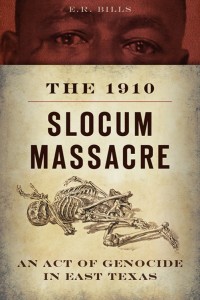 On Saturday, January 16, a historical marker commemorating the 1910 Slocum Massacre (click for audio and text) and listing the names of its officially acknowledged victims will be unveiled in East Texas’ Anderson County. The marker is the first in Texas acknowledging racial violence against African Americans. A dedication ceremony will be held at the Slocum ISD cafeteria auditorium (5765 E. State Hwy 294, 75839) at 1 p.m.
On Saturday, January 16, a historical marker commemorating the 1910 Slocum Massacre (click for audio and text) and listing the names of its officially acknowledged victims will be unveiled in East Texas’ Anderson County. The marker is the first in Texas acknowledging racial violence against African Americans. A dedication ceremony will be held at the Slocum ISD cafeteria auditorium (5765 E. State Hwy 294, 75839) at 1 p.m.
Slocum is 60 miles south of Tyler, and the marker will be placed a short distance south of the school on the west side of FM 2022. Dr. Malachi Crawford, assistant director of the African American Studies Program at the University of Houston, will be keynote speaker for the dedication.
The Slocum incident is one of the darkest moments in Texas history. It began on July 29 after false rumors of an African American uprising began circulating. Armed white men from all over the region began pouring into Slocum and killing black people at will. The carnage went on for two days and though dozens of black victims were reported slain, authorities identified only eight.
“Men were going about killing Negroes as fast as they could find them,” said Anderson County sheriff William Black. “And, so far as I was able to ascertain, without any real cause. I don’t know how many
The bloodshed forced many African Americans to abandon their homes, property and businesses and flee for their lives. Sheriff Black and District Judge Benjamin H. Gardner worked diligently to hold the perpetrators responsible and seven white men were indicted, but the case was never prosecuted. Black and Gardner were shortly voted out of office and the indictments they secured were transferred to Harris County and subsequently ignored.
Most of the identified casualties of the event were interred in an unmarked mass grave which, to date, has not been located. Neither the dead nor their disenfranchised relatives ever received justice or recompense and the white population of the Slocum area was permitted to claim or re-purpose the abandoned African American properties as they saw fit and consign the affair to oblivion.
On March 30, 2011, a month after reporter Tim Madigan’s two-part investigative feature revisiting the atrocity appeared in the Fort Worth Star-Telegram, the 82nd Texas Legislature adopted House of Representatives Resolution 865 (filed by Reps. Marc Veasey – Texas House District 95 and Lon Burnam – Texas House District 90), officially acknowledging that the Slocum Massacre occurred. Three years later, after publication of The 1910 Slocum Massacre: An Act of Genocide in East Texas (History Press, 2014), author E. R. Bills and Slocum Massacre descendant Constance Hollie-Jawaid petitioned the Texas Historical Commission for a historical marker commemorating the incident and their request was approved on January 29, 2015.
For more information, contact Constance Hollie-Jawaid — constancejawaid@yahoo.com, 214-842-1221, or E. R. Bills — erbillsthinks@gmail.com, 817-454-3189.
“Black Ice”: African origins in the sport of ice hockey
Twenty-two years before the 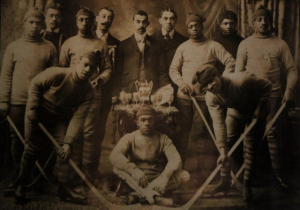 National Hockey League formed, there was the Colored Hockey League of Maritimes headquartered in Halifax, Nova Scotia. The all-black league came to be in 1894 with over 12 teams of African-Canadian players. The league’s organizers were, according to the book Black Ice: The Lost History of the Colored Hockey League of the Maritimes, 1895-1925, “…more than educated Blacks, in fact they were the first generation of Black men who refused to answer the ageless question: “Whose Negro Are You?” The first of their race to demand what was rightfully theirs; the first generation to refuse to stand at the back of a line.”
National Hockey League formed, there was the Colored Hockey League of Maritimes headquartered in Halifax, Nova Scotia. The all-black league came to be in 1894 with over 12 teams of African-Canadian players. The league’s organizers were, according to the book Black Ice: The Lost History of the Colored Hockey League of the Maritimes, 1895-1925, “…more than educated Blacks, in fact they were the first generation of Black men who refused to answer the ageless question: “Whose Negro Are You?” The first of their race to demand what was rightfully theirs; the first generation to refuse to stand at the back of a line.”
Their games were arranged by formal invitation only and despite hardships, criticism, and prejudice, the league existed well into the mid-1920s with teams such as the Dartmouth Jubilees, the Halifax Eurekas, and the Truro Sheiks. The league used the teachings of Booker T. Washington, the Bible and speech resources from the Underground Railroad in their plays and strategies on the ice. Racial discrimination eventually caused the teams to dissolve.
Read here and see the ESPN video about the league’s history and how it has yet to be acknowledged by the NHL.
As an aside, the page also has a moving video about the controversial destruction in the late 1960s of Africville, a small black settlement within the city limits of Halifax and home to the 1901 CHL champion Africville Seasides. Many of the first Africville settlers were former slaves from the United States during the American Revolutionary War. In the 1960s, Africville families were uprooted and their homes demolished in the name of urban renewal and integration.
Also: Willie O’Ree, the NHL’s first black player.
TBHPP Bookshelf
Published 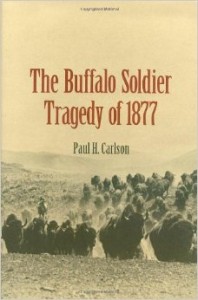 scholarship on black history in Texas is growing and we’d like to share with you some suggested readings, both current and past, from some of the preeminent history scholars in Texas and beyond. We invite you to take a look at our bookshelf page — including a featured selection — and check back as the list grows. A different selection will be featured each week. We welcome suggestions and reviews. This week, we offer “The Buffalo Soldier Tragedy of 1877,” by Paul H. Carlson.
scholarship on black history in Texas is growing and we’d like to share with you some suggested readings, both current and past, from some of the preeminent history scholars in Texas and beyond. We invite you to take a look at our bookshelf page — including a featured selection — and check back as the list grows. A different selection will be featured each week. We welcome suggestions and reviews. This week, we offer “The Buffalo Soldier Tragedy of 1877,” by Paul H. Carlson.
In the middle of the arid summer of 1877, a drought year in West Texas, a troop of some forty buffalo soldiers (African American cavalry led by white officers) struck out into the Llano Estacado from Double Lakes, south of modern Lubbock, pursuing a band of Kwahada Comanches who had been raiding homesteads and hunting parties. A group of twenty-two buffalo hunters accompanied the soldiers as guides and allies.
Several days later three black soldiers rode into Fort Concho at modern San Angelo and reported that the men and officers of Troop A were missing and presumed dead from thirst. The “Staked Plains Horror,” as the Galveston Daily News called it, quickly captured national attention. Although most of the soldiers eventually straggled back into camp, four had died, and others eventually faced court-martial for desertion. The buffalo hunters had ridden off on their own to find water, and the surviving soldiers had lived by drinking the blood of their dead horses and their own urine. A routine army scout had turned into disaster of the worst kind.
This Week In Texas Black History, Jan. 3-9
Calendar courtesy Texas Black History Preservation Project
3 – On this d 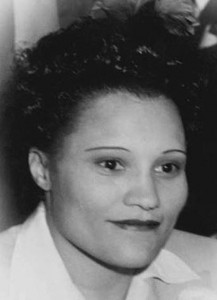 ay in 1912, the founder of the Fatburger restaurant chain, Lovie Louise Yancey, was born in Bastrop. She moved to Los Angeles in the mid-1940s and at age 35 partnered with Charles Simpson to open their first restaurant, a three-stool hamburger stand in
ay in 1912, the founder of the Fatburger restaurant chain, Lovie Louise Yancey, was born in Bastrop. She moved to Los Angeles in the mid-1940s and at age 35 partnered with Charles Simpson to open their first restaurant, a three-stool hamburger stand in ![Fatburger Logo [F1]](https://www.pvamu.edu/tiphc/wp-content/uploads/sites/107/2016/01/Fatburger-Logo-F1-300x247.jpg) South Central Los Angeles in 1947. They called the business Mr. Fatburger, dropping the “Mr.” in 1952. By the end of 1985, the chain had over fifteen franchise sites throughout southern California. Noted as “The Last Great Hamburger Stand,” Fatburger now has restaurants in 29 countries, including China, Pakistan and the United Arab Emirates. Yancey established a $1.7-million endowment at the City of Hope National Medical Center in Duarte, California in 1986 for research into sickle-cell anemia as a dedication to her grandson who died of the disease. Yancey died of pneumonia on January 26, 2008, at the age of 96.
South Central Los Angeles in 1947. They called the business Mr. Fatburger, dropping the “Mr.” in 1952. By the end of 1985, the chain had over fifteen franchise sites throughout southern California. Noted as “The Last Great Hamburger Stand,” Fatburger now has restaurants in 29 countries, including China, Pakistan and the United Arab Emirates. Yancey established a $1.7-million endowment at the City of Hope National Medical Center in Duarte, California in 1986 for research into sickle-cell anemia as a dedication to her grandson who died of the disease. Yancey died of pneumonia on January 26, 2008, at the age of 96.
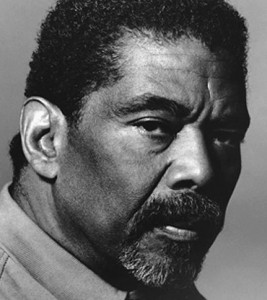 5 – Alvin Ailey, dancer, choreographer and founder of the world famous Alvin Ailey Dance Theater was born on this day in 1931 in Rogers (Bell County). He made his Broadway debut in 1954 and in 1958 gained his first critical success for his choreography for Blues Suite, which also marked the beginning of the Alvin Ailey Dance Company. His troupe, in 1970, became the first American dance company to tour the USSR in 50 years and received a 20-minute ovation for their performance in Leningrad.
5 – Alvin Ailey, dancer, choreographer and founder of the world famous Alvin Ailey Dance Theater was born on this day in 1931 in Rogers (Bell County). He made his Broadway debut in 1954 and in 1958 gained his first critical success for his choreography for Blues Suite, which also marked the beginning of the Alvin Ailey Dance Company. His troupe, in 1970, became the first American dance company to tour the USSR in 50 years and received a 20-minute ovation for their performance in Leningrad.
 5 — The University of Texas at Austin made a historic hire on this day in 2014 when it announced that Charlie Strong would become the school’s new head football coach, making him the program’s 29th head coach and the first African American to hold the position since UT began playing football in 1893. In fact, he also became the first black coach for any of the school’s major men’s programs. Strong, 59, signed a five-year deal paying him $5 million annually making the Batesville, Ark. native one of the highest paid coaches in the country.
5 — The University of Texas at Austin made a historic hire on this day in 2014 when it announced that Charlie Strong would become the school’s new head football coach, making him the program’s 29th head coach and the first African American to hold the position since UT began playing football in 1893. In fact, he also became the first black coach for any of the school’s major men’s programs. Strong, 59, signed a five-year deal paying him $5 million annually making the Batesville, Ark. native one of the highest paid coaches in the country.
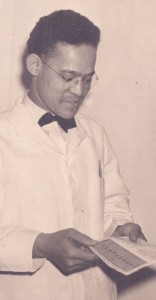 8 – Theodore Roosevelt Youngblood, Sr. was born on this day in 1903 in Limestone County (east of Waco). Youngblood was a civic leader and headwaiter at the Driskill Hotel and Stephen F. Austin hotels in Austin. He received a bachelor of arts degree in history in 1927 from Samuel Huston College (now Huston-Tillotson University), however, his employment opportunities were limited to jobs such as porter at the Capitol and waiter at Austin hotels. He served as headwaiter at the Driskill and the Stephen F. Austin Hotel from the 1930s until his retirement in 1968. At those hotels, he put together and served receptions, dinner parties, and meetings for prominent white politicians, businessmen, educators, and cattlemen for the Austin area and the state of Texas including President Lyndon B. Johnson and governors Dolph Briscoe, John Connally, and Allan Shivers. Youngblood was chairman of the Negro Chamber of Commerce and president of the Huston College alumni association. He also entertained at his home many well-known black leaders such as NAACP attorney Thurgood Marshall. Youngblood died on February 9, 1993, at age 90.
8 – Theodore Roosevelt Youngblood, Sr. was born on this day in 1903 in Limestone County (east of Waco). Youngblood was a civic leader and headwaiter at the Driskill Hotel and Stephen F. Austin hotels in Austin. He received a bachelor of arts degree in history in 1927 from Samuel Huston College (now Huston-Tillotson University), however, his employment opportunities were limited to jobs such as porter at the Capitol and waiter at Austin hotels. He served as headwaiter at the Driskill and the Stephen F. Austin Hotel from the 1930s until his retirement in 1968. At those hotels, he put together and served receptions, dinner parties, and meetings for prominent white politicians, businessmen, educators, and cattlemen for the Austin area and the state of Texas including President Lyndon B. Johnson and governors Dolph Briscoe, John Connally, and Allan Shivers. Youngblood was chairman of the Negro Chamber of Commerce and president of the Huston College alumni association. He also entertained at his home many well-known black leaders such as NAACP attorney Thurgood Marshall. Youngblood died on February 9, 1993, at age 90.
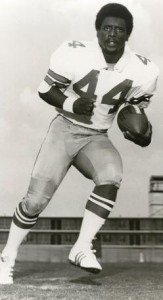 9 – On this date in 1950 Dallas Cowboys running back Robert Newhouse was born in Longview. He starred at Galilee High School in Hallsville, situated between Longview and Marshall. The University of Houston was the only major school recruiting offer he received and with the Cougars, from 1969-1971, Newhouse set several rushing records and left the school as its all-time single-season rushing leader with 1,757 yards as a senior. That total, at the time, was the second most rushing yards in a season in NCAA history and earned Newhouse second team All-American honors. He was a second round draft pick by the Cowboys in 1972 and played all of his 12 NFL seasons with Dallas. Newhouse led the team in rushing with 930 yards in 1975.
9 – On this date in 1950 Dallas Cowboys running back Robert Newhouse was born in Longview. He starred at Galilee High School in Hallsville, situated between Longview and Marshall. The University of Houston was the only major school recruiting offer he received and with the Cougars, from 1969-1971, Newhouse set several rushing records and left the school as its all-time single-season rushing leader with 1,757 yards as a senior. That total, at the time, was the second most rushing yards in a season in NCAA history and earned Newhouse second team All-American honors. He was a second round draft pick by the Cowboys in 1972 and played all of his 12 NFL seasons with Dallas. Newhouse led the team in rushing with 930 yards in 1975.
Blog: Ron Goodwin, author, PVAMU history professor
Ron Good  win’s bi-weekly blog appears exclusively for TIPHC/TBHPP. Goodwin is a San Antonio native and Air Force veteran. Generally, his column will address contemporary issues in the black community and how they relate to black history. He and the TIPHC/TBHPP staff welcome your comments. In his latest blog, “Pressing Forward,” Goodwin looks ahead at the new year and the changing paradigm for academic success in the black community. Read it
win’s bi-weekly blog appears exclusively for TIPHC/TBHPP. Goodwin is a San Antonio native and Air Force veteran. Generally, his column will address contemporary issues in the black community and how they relate to black history. He and the TIPHC/TBHPP staff welcome your comments. In his latest blog, “Pressing Forward,” Goodwin looks ahead at the new year and the changing paradigm for academic success in the black community. Read it
Submissions wanted
Historians, scholars, students, lend us your…writings. Help us produce the most comprehensive documentation ever undertaken for the African American experience in Texas. We encourage you to contribute items about people, places, events, issues, politics/legislation, sports, entertainment, religion, etc., as general entries or essays. Our documentation is wide-ranging and diverse, and you may research and write about the subject of your interest or, to start, please consult our list of suggested biographical entries and see submission guidelines. However, all topics must be approved by TIPHC/TBHPP editors before beginning your research/writing.
We welcome your questions or comments via email or telephone – mdhurd@pvamu.edu, 936-261-9836.
